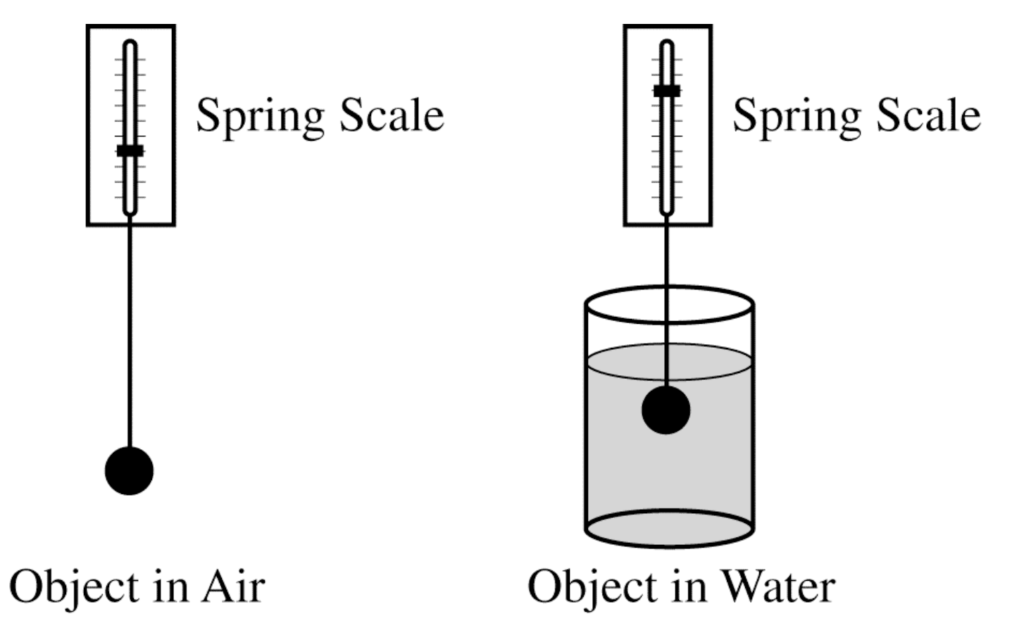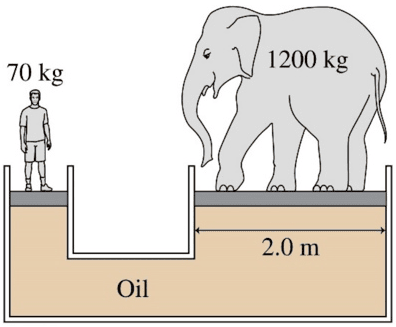0 attempts
0% avg
UBQ Credits
| Derivation/Formula | Reasoning |
|---|---|
| \[0 = v_{iy}^2 – 2 g h\] | At maximum height the vertical speed is zero, so using \(v_y^2 = v_{iy}^2 – 2 g \Delta y\) with \(\Delta y = h\). |
| \[v_{iy} = \sqrt{2 g h}\] | Solve the previous equation for the initial vertical component \(v_{iy}\). |
| \[v_0 = \frac{v_{iy}}{\sin\theta}\] | Relate total launch speed to its vertical component using \(v_{iy} = v_0 \sin\theta\). |
| \[\boxed{v_0 \approx 2.24\,\text{m/s}}\] | Insert \(g = 9.80\,\text{m/s}^2\), \(h = 0.150\,\text{m}\), and \(\theta = 50^{\circ}\). |
| Derivation/Formula | Reasoning |
|---|---|
| \[A_f = \pi r_f^2\] | Cross-sectional area of the fountain opening with radius \(r_f = 4.00\times10^{-3}\,\text{m}\). |
| \[Q = A_f v_0\] | Volume flow rate equals area times exit speed \(v_0\). |
| \[\boxed{Q \approx 1.13\times10^{-4}\,\text{m}^3/\text{s}}\] | Insert \(A_f = 5.03\times10^{-5}\,\text{m}^2\) and \(v_0 = 2.24\,\text{m/s}\). |
| Derivation/Formula | Reasoning |
|---|---|
| \[A_p = \pi r_p^2\] | Area of feeder pipe with \(r_p = 7.00\times10^{-3}\,\text{m}\). |
| \[v_p = \frac{A_f}{A_p} v_0\] | Continuity equation \(A_f v_0 = A_p v_p\) gives pipe speed \(v_p\). |
| \[P_p + \tfrac{1}{2}\rho v_p^2 + \rho g y_p = P_0 + \tfrac{1}{2}\rho v_0^2 + \rho g y_0\] | Bernoulli between pipe point (subscript \(p\)) and nozzle (subscript \(0\)); nozzle pressure is atmospheric, taken as zero gauge. |
| \[P_p = \tfrac{1}{2}\rho (v_0^2 – v_p^2) + \rho g (y_0 – y_p)\] | Rearrange for gauge pressure; \(y_0 = 0\) at nozzle, \(y_p = -3.00\,\text{m}\). |
| \[\boxed{P_p \approx 3.16\times10^{4}\,\text{Pa}}\] | Insert \(\rho = 1.0\times10^{3}\,\text{kg/m}^3\), \(v_0 = 2.24\,\text{m/s}\), \(v_p = 0.731\,\text{m/s}\), and \(g = 9.80\,\text{m/s}^2\). |
Just ask: "Help me solve this problem."

An object is suspended from a spring scale first in air, then in water, as shown in the figure above. The spring scale reading in air is \( 17.8 \) \( \text{N} \), and the spring scale reading when the object is completely submerged in water is \( 16.2 \) \( \text{N} \). The density of water is \( 1000 \) \( \text{kg/m}^3 \).
Which of the following statements is an expression of the equation of continuity?
One end of a spring is attached to a solid wall while the other end just reaches to the edge of a horizontal, frictionless tabletop, which is a distance \(h\) above the floor. A block of mass \(M\) is placed against the end of the spring and pushed toward the wall until the spring has been compressed a distance \(x\). The block is released and strikes the floor a horizontal distance \(D\) from the edge of the table. Air resistance is negligible. Derive expressions for the following quantities only in terms of \(M, x, D, h,\) and any constants.

The \( 70 \) \( \text{kg} \) student in the figure balances a \( 1200 \) \( \text{kg} \) elephant on a hydraulic lift. Assume that it is filled with oil, which is incompressible and has a density \( \rho = 900 \) \( \text{kg/m}^3 \). What is the diameter of the piston the student is standing on? Assume each piston has a cylindrical shape, i.e., a circular cross-sectional area. Note: The two pistons are at the same height. Also, the diameter of the wider piston is given in the figure to be \( 2.0 \) \( \text{m} \).
A sphere of mass \(0.5\) \(\text{kg}\) is dropped into a column of oil. At the instant the sphere becomes completely submerged in the oil, the sphere is moving downward at \(8\) \(\text{m/s}\), the buoyancy force on the sphere is \(4.0\) \(\text{N}\), and the fluid frictional force is \(4.0\) \(\text{N}\). Which of the following describes the motion of the sphere at this instant?
\(2.24\,\text{m/s}\)
\(1.13\times10^{-4}\,\text{m}^3/\text{s}\)
\(3.16\times10^{4}\,\text{Pa}\)
By continuing you (1) agree to our Terms of Use and Terms of Sale and (2) consent to sharing your IP and browser information used by this site’s security protocols as outlined in our Privacy Policy.
| Kinematics | Forces |
|---|---|
| \(\Delta x = v_i t + \frac{1}{2} at^2\) | \(F = ma\) |
| \(v = v_i + at\) | \(F_g = \frac{G m_1 m_2}{r^2}\) |
| \(v^2 = v_i^2 + 2a \Delta x\) | \(f = \mu N\) |
| \(\Delta x = \frac{v_i + v}{2} t\) | \(F_s =-kx\) |
| \(v^2 = v_f^2 \,-\, 2a \Delta x\) |
| Circular Motion | Energy |
|---|---|
| \(F_c = \frac{mv^2}{r}\) | \(KE = \frac{1}{2} mv^2\) |
| \(a_c = \frac{v^2}{r}\) | \(PE = mgh\) |
| \(T = 2\pi \sqrt{\frac{r}{g}}\) | \(KE_i + PE_i = KE_f + PE_f\) |
| \(W = Fd \cos\theta\) |
| Momentum | Torque and Rotations |
|---|---|
| \(p = mv\) | \(\tau = r \cdot F \cdot \sin(\theta)\) |
| \(J = \Delta p\) | \(I = \sum mr^2\) |
| \(p_i = p_f\) | \(L = I \cdot \omega\) |
| Simple Harmonic Motion | Fluids |
|---|---|
| \(F = -kx\) | \(P = \frac{F}{A}\) |
| \(T = 2\pi \sqrt{\frac{l}{g}}\) | \(P_{\text{total}} = P_{\text{atm}} + \rho gh\) |
| \(T = 2\pi \sqrt{\frac{m}{k}}\) | \(Q = Av\) |
| \(x(t) = A \cos(\omega t + \phi)\) | \(F_b = \rho V g\) |
| \(a = -\omega^2 x\) | \(A_1v_1 = A_2v_2\) |
| Constant | Description |
|---|---|
| [katex]g[/katex] | Acceleration due to gravity, typically [katex]9.8 , \text{m/s}^2[/katex] on Earth’s surface |
| [katex]G[/katex] | Universal Gravitational Constant, [katex]6.674 \times 10^{-11} , \text{N} \cdot \text{m}^2/\text{kg}^2[/katex] |
| [katex]\mu_k[/katex] and [katex]\mu_s[/katex] | Coefficients of kinetic ([katex]\mu_k[/katex]) and static ([katex]\mu_s[/katex]) friction, dimensionless. Static friction ([katex]\mu_s[/katex]) is usually greater than kinetic friction ([katex]\mu_k[/katex]) as it resists the start of motion. |
| [katex]k[/katex] | Spring constant, in [katex]\text{N/m}[/katex] |
| [katex] M_E = 5.972 \times 10^{24} , \text{kg} [/katex] | Mass of the Earth |
| [katex] M_M = 7.348 \times 10^{22} , \text{kg} [/katex] | Mass of the Moon |
| [katex] M_M = 1.989 \times 10^{30} , \text{kg} [/katex] | Mass of the Sun |
| Variable | SI Unit |
|---|---|
| [katex]s[/katex] (Displacement) | [katex]\text{meters (m)}[/katex] |
| [katex]v[/katex] (Velocity) | [katex]\text{meters per second (m/s)}[/katex] |
| [katex]a[/katex] (Acceleration) | [katex]\text{meters per second squared (m/s}^2\text{)}[/katex] |
| [katex]t[/katex] (Time) | [katex]\text{seconds (s)}[/katex] |
| [katex]m[/katex] (Mass) | [katex]\text{kilograms (kg)}[/katex] |
| Variable | Derived SI Unit |
|---|---|
| [katex]F[/katex] (Force) | [katex]\text{newtons (N)}[/katex] |
| [katex]E[/katex], [katex]PE[/katex], [katex]KE[/katex] (Energy, Potential Energy, Kinetic Energy) | [katex]\text{joules (J)}[/katex] |
| [katex]P[/katex] (Power) | [katex]\text{watts (W)}[/katex] |
| [katex]p[/katex] (Momentum) | [katex]\text{kilogram meters per second (kgm/s)}[/katex] |
| [katex]\omega[/katex] (Angular Velocity) | [katex]\text{radians per second (rad/s)}[/katex] |
| [katex]\tau[/katex] (Torque) | [katex]\text{newton meters (Nm)}[/katex] |
| [katex]I[/katex] (Moment of Inertia) | [katex]\text{kilogram meter squared (kgm}^2\text{)}[/katex] |
| [katex]f[/katex] (Frequency) | [katex]\text{hertz (Hz)}[/katex] |
General Metric Conversion Chart
Example of using unit analysis: Convert 5 kilometers to millimeters.
Start with the given measurement: [katex]\text{5 km}[/katex]
Use the conversion factors for kilometers to meters and meters to millimeters: [katex]\text{5 km} \times \frac{10^3 \, \text{m}}{1 \, \text{km}} \times \frac{10^3 \, \text{mm}}{1 \, \text{m}}[/katex]
Perform the multiplication: [katex]\text{5 km} \times \frac{10^3 \, \text{m}}{1 \, \text{km}} \times \frac{10^3 \, \text{mm}}{1 \, \text{m}} = 5 \times 10^3 \times 10^3 \, \text{mm}[/katex]
Simplify to get the final answer: [katex]\boxed{5 \times 10^6 \, \text{mm}}[/katex]
Prefix | Symbol | Power of Ten | Equivalent |
|---|---|---|---|
Pico- | p | [katex]10^{-12}[/katex] | 0.000000000001 |
Nano- | n | [katex]10^{-9}[/katex] | 0.000000001 |
Micro- | µ | [katex]10^{-6}[/katex] | 0.000001 |
Milli- | m | [katex]10^{-3}[/katex] | 0.001 |
Centi- | c | [katex]10^{-2}[/katex] | 0.01 |
Deci- | d | [katex]10^{-1}[/katex] | 0.1 |
(Base unit) | – | [katex]10^{0}[/katex] | 1 |
Deca- or Deka- | da | [katex]10^{1}[/katex] | 10 |
Hecto- | h | [katex]10^{2}[/katex] | 100 |
Kilo- | k | [katex]10^{3}[/katex] | 1,000 |
Mega- | M | [katex]10^{6}[/katex] | 1,000,000 |
Giga- | G | [katex]10^{9}[/katex] | 1,000,000,000 |
Tera- | T | [katex]10^{12}[/katex] | 1,000,000,000,000 |
The most advanced version of Phy. 50% off, for early supporters. Prices increase soon.
per month
Billed Monthly. Cancel Anytime.
Trial –> Phy Pro
We crafted THE Ultimate A.P Physics 1 course so you can learn faster and score higher.
Try our free calculator to see what you need to get a 5 on the upcoming AP Physics 1 exam.
A quick explanation
Credits are used to grade your FRQs and GQs. Pro users get unlimited credits.
Submitting counts as 1 attempt.
Viewing answers or explanations count as a failed attempts.
Phy gives partial credit if needed
MCQs and GQs are are 1 point each. FRQs will state points for each part.
Phy customizes problem explanations based on what you struggle with. Just hit the explanation button to see.
Understand you mistakes quicker.

Phy automatically provides feedback so you can improve your responses.
10 Free Credits To Get You Started

By continuing you agree to nerd-notes.com Terms of Service, Privacy Policy, and our usage of user data.
NEW! PHY AI accurately solves all questions
🔥 Get up to 30% off Elite Physics Tutoring
🧠 NEW! Learn Physics From Scratch Self Paced Course
🎯 Need exam style practice questions?